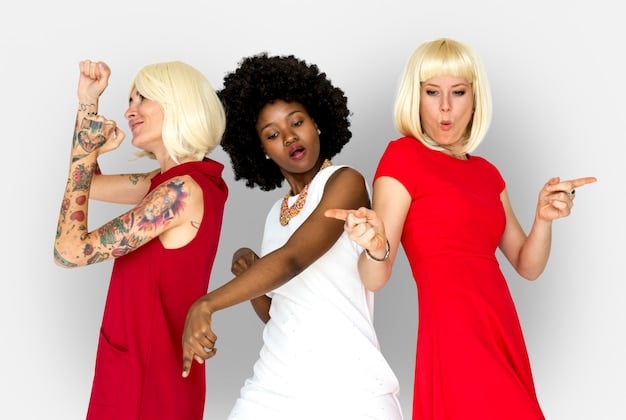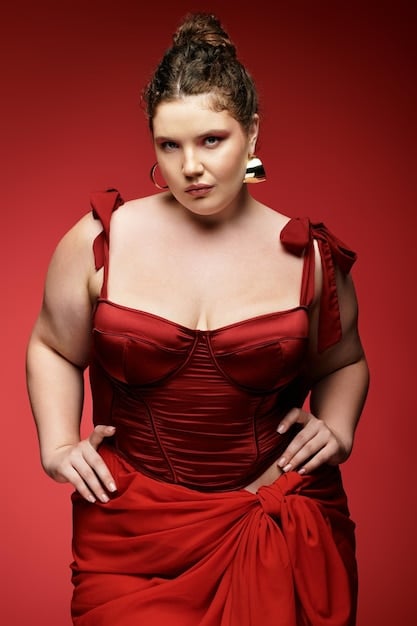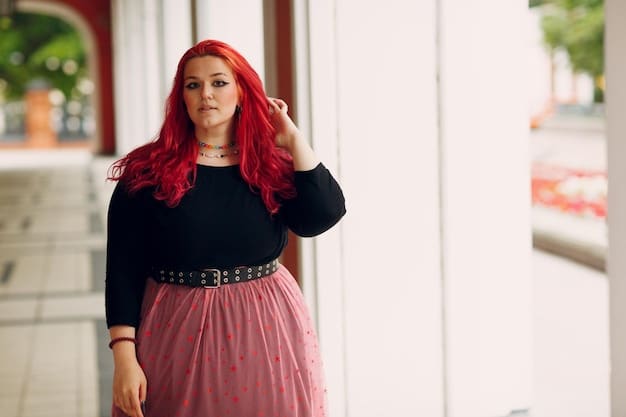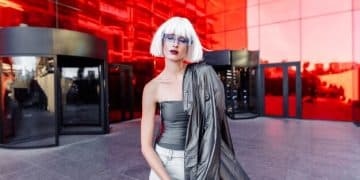Red Carpet Body Positivity: Celebrating Diverse Styles

Anúncios
Red Carpet Body Positivity emphasizes celebrating diverse body types and styles at high-profile events, fostering inclusivity and representation in fashion and media.
The red carpet is evolving into a platform that celebrates diversity and inclusivity, challenging traditional beauty standards and promoting Red Carpet Body Positivity.
Anúncios
Red Carpet’s Evolving Landscape
The red carpet has historically been a stage for showcasing a narrow definition of beauty. However, recent years have seen a significant shift towards embracing body positivity and celebrating diverse body types. This evolution reflects a broader cultural movement towards inclusivity and representation.
This change isn’t just about aesthetics; it’s about empowering individuals and challenging the unrealistic expectations often perpetuated by the media. By showcasing a variety of body shapes and sizes, the red carpet can inspire confidence and promote a healthier body image.
Anúncios

Key Figures Championing Body Positivity
Several celebrities and influencers have played a pivotal role in promoting body positivity on the red carpet. These individuals use their platform to challenge conventional norms and advocate for greater representation.
Their actions often spark important conversations about beauty standards, self-acceptance, and the importance of seeing oneself reflected in mainstream media.
Ashley Graham’s Impact
Ashley Graham, a prominent plus-size model, has consistently used her red carpet appearances to advocate for body positivity. Her confidence and willingness to challenge industry norms have made her a role model for many.
Lizzo’s Bold Statements
Lizzo, a Grammy-winning artist, is known for her unapologetic embrace of her body and her commitment to promoting self-love. Her red carpet looks often celebrate her curves and challenge traditional fashion rules.
- Promoting self-acceptance through fashion.
- Challenging industry standards of beauty.
- Inspiring confidence in individuals of all sizes.
- Using fashion as a form of self-expression and empowerment.
By embracing their authentic selves and using their influence to promote body positivity, these figures are helping to create a more inclusive and accepting red carpet landscape.
Fashion’s Role in Body Positivity
The fashion industry plays a crucial role in promoting body positivity on the red carpet. Designers and stylists are increasingly recognizing the importance of creating clothing that celebrates diverse body types.
This involves offering a wider range of sizes, designing garments that flatter different shapes, and embracing inclusive marketing practices.
Designing for All Body Types
Some designers are now specializing in creating custom-made gowns and outfits for individuals of all sizes. These designs often prioritize comfort, fit, and the celebration of unique body shapes.
Inclusive Styling Practices
Stylists are also becoming more attuned to the needs of diverse clients, offering personalized advice and creating looks that enhance their natural beauty. This involves challenging the traditional one-size-fits-all approach to styling.

By prioritizing inclusivity and creating clothing that celebrates diverse body types, the fashion industry can contribute to a more positive and empowering red carpet experience.
The Media’s Power and Responsibility
The media has a significant influence on shaping perceptions of beauty and body image. Therefore, it plays a crucial role in promoting body positivity on the red carpet.
By showcasing a diverse range of body types and celebrating authenticity, the media can help challenge unrealistic beauty standards and promote a more inclusive representation of beauty.
Highlighting Diverse Representation
Media outlets can prioritize featuring celebrities and influencers who represent a variety of body types, skin tones, and backgrounds. This can help break down barriers and challenge the traditional narrow definition of beauty.
Challenging Harmful Narratives
The media can also play a role in challenging harmful narratives and stereotypes about body size and shape. By promoting body positivity, the media can contribute to a more accepting and supportive environment.
- Showcasing diverse body types in media coverage
- Promoting stories that highlight self-acceptance and body confidence
- Challenging harmful stereotypes about weight and appearance
- Using inclusive language and avoiding body-shaming terms
By embracing its power and responsibility, the media can significantly contribute to the promotion of body positivity on the red carpet and beyond.
Social Media’s Influence on Red Carpet Body Positivity
Social media platforms have emerged as powerful tools for promoting body positivity and challenging traditional media narratives. They provide individuals with a platform to share their experiences, connect with like-minded people, and advocate for change.
The democratization of media through social platforms has enabled a more direct and personal dialogue around body image and representation on the red carpet.
#BodyPositive Movement
The #BodyPositive hashtag has become a rallying cry for individuals who are passionate about promoting body acceptance and challenging unrealistic beauty standards. It encourages users to share their stories, images, and messages of self-love.
Direct Engagement with Celebrities
Social media allows individuals to directly engage with celebrities and influencers, expressing appreciation for their body positivity efforts and challenging them to do more. This direct feedback can be impactful in shaping their actions and messaging.
Social media’s influence on red carpet body positivity is undeniable, offering a space for empowerment, advocacy, and community building.
Future Trends in Red Carpet Inclusivity
The red carpet is likely to become even more inclusive in the future, with a greater emphasis on celebrating diversity and promoting body positivity. Several trends are shaping this evolution.
From technological advancements to shifts in cultural attitudes, the future of red carpet inclusivity holds significant promise.
Virtual Red Carpets
The rise of virtual events and digital fashion shows may create new opportunities for showcasing diverse body types and styles. These platforms can be more accessible and inclusive than traditional red carpets.
AI-Powered Styling Tools
Artificial intelligence (AI) is being used to develop personalized styling tools that can help individuals find clothing and outfits that flatter their unique body shapes. This technology could further empower individuals to embrace their bodies and express their personal style.
- Increased representation of diverse body types
- Technological advancements that promote inclusivity
- Shifts in cultural attitudes towards beauty and body image
- Greater collaboration between celebrities, designers, and stylists
By embracing these trends and continuing to push for greater inclusivity, the red carpet can become a true reflection of the diverse and beautiful world we live in.
Challenges and Continued Efforts
Despite the progress made in promoting body positivity on the red carpet, challenges remain. There is still work to be done to ensure that all individuals feel represented and celebrated.
Overcoming these challenges requires a sustained effort from all stakeholders, including celebrities, designers, media outlets, and the public.
Combating Tokenism
It is important to move beyond tokenism and ensure that diverse representation is not just a superficial gesture. This requires a genuine commitment to inclusivity and a willingness to challenge systemic biases.
Addressing Negative Commentary
Negative commentary and body-shaming remarks continue to plague social media and media coverage. Addressing this requires promoting respectful dialogue and holding individuals accountable for their words and actions.
While challenges remain, the ongoing efforts to promote body positivity on the red carpet are paving the way for a more inclusive and empowering future. Each step forward contributes to a shift in cultural attitudes and a celebration of genuine beauty in all its forms.
| Key Point | Brief Description |
|---|---|
| 🌟 Diverse Representation | Celebrating various body types on the red carpet. |
| 💃 Fashion’s Role | Designing inclusive clothing for all shapes and sizes. |
| 📱 Social Media Impact | Using platforms to promote body positivity and self-love. |
| 🎬 Media Responsibility | Challenging harmful narratives and promoting positive representation. |
Frequently Asked Questions
▼
Body positivity on the red carpet involves celebrating diverse body types and styles, promoting inclusivity, and challenging traditional beauty standards often associated with these events. It aims to represent all individuals.
▼
The red carpet has become more inclusive through increased representation of diverse celebrities, designers creating clothing for all body types, and media outlets highlighting body-positive stories. This shifts cultural attitudes.
▼
Key figures include Ashley Graham and Lizzo, who consistently use their platforms to promote self-love, challenge unrealistic beauty standards, and inspire confidence in people of all shapes and sizes.
▼
Fashion plays a crucial role by designing clothing that flatters diverse body types, offering a wider range of sizes, and embracing inclusive styling practices. These efforts make fashion accessible and empowering for all.
▼
Social media amplifies body positivity through hashtags like #BodyPositive, allowing direct engagement with celebrities and influencers, and providing a platform for individuals to share their experiences and connect with others.
Conclusion
Celebrating Red Carpet Body Positivity is essential for challenging traditional beauty standards and fostering a more inclusive and empowering environment. By embracing diversity and promoting self-acceptance, the red carpet can inspire confidence and contribute to a more positive representation of beauty for everyone.





